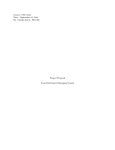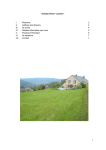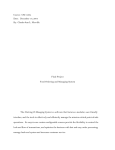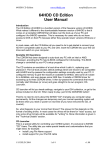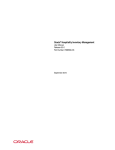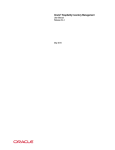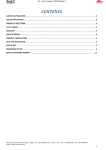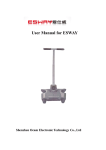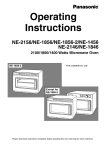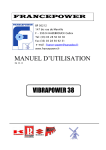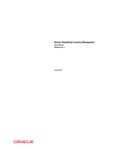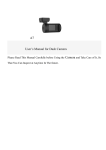Download Course: CSC 400L - Southern Connecticut State University
Transcript
Course: CSC 400/01L Date: October 21, 2004 By: Claude-Jean L. Merville Project Progress Report Food Ordering & Managing System MERVILLE 2 Statement of Project The Ordering & Managing System is a software product that features a modular, userfriendly interface, and the tools to effectively and efficiently manage the mission-critical pointof-sale operations. Its easy-to-use custom configurable screens provide the flexibility to control the look and flow of transactions, and optimize the business with fast and easy order processing; manage back-end system and increases customer service. This state-of-the-art software is specifically being designed for the family-owned restaurant called the Claudy-FRESH Grille on the Beach located in Norwalk, Connecticut. The restaurant has been operating for twenty one years without a computerized ordering system. Hence, for the past four years, the ordering process at Claudy’s has been badly backed up; especially in the summer time when it gets real busy. The objective of this software is to facilitate food ordering process, provide good customer service and help increase employee productivity at Claudy-FRESH Grille on the Beach. The owners of Claudy’s have been wanted something like this for a long time and their need for this system grew steadily. Without a doubt, their ordering process will be taken to a new level and will be beneficial for both the customer and the staff. Progress-to-Date Although progress thus far has not followed the project schedule, there have been six major steps completed. Firstly, the Login Screen was designed, and the login coding was then done. Second, the Main Screen was designed with different components and sub menu buttons. Thirdly, the Combo Meals Sub-Screen was designed, and the order process from the Main Screen has been coded to display two items from the Combo Meals Sub-Screen. Fourthly, the MERVILLE 3 Discount Menu was designed and coded to displayed discount for “$1 coupon, and 10% off”. Fifthly, the Tender Screen was also designed and coded to accept cash for “exact amount, and $5, $10, $20, $50, $100 dollar bills”. Lastly, the Logout buttons from the Main and Login Screens were coded to exit the system. The Login Screen is without a doubt the master key of the software. In order for an employee or a manager to be able to process an order, he or she will need to log into the system. If a user account has not been set up, then he or she will not be able to access the Main Screen, even to place an order. Without the username and password, the software would be useless for them. Therefore, the Login Screen coding was a major step to consider and accomplished. The second major step was to design the Main Screen, which plays an important role in the software. This Main Screen can be considered as a reference point in the program. This is the only screen that allows a user to connect to all the other screens within the software. In other words, the Main Screen acts like an information/option server that allows users to navigate thru the network of screens. And without it, a user would not be able to access the other screens within the software. After designing the Main Screen, the Combo Meals Sub Screen and the order process coding were also essential steps of the project creation. For that matter, from the Combo Meal Screen, two specific items (cheeseburger, hamburger) have already been coded to be displayed in the “current order in process” screen. The third major step was to design the Discount Menu. As it is frequently encountered in any business, discounts have always been made available to special and outstanding customers. And in order to facilitate the Tender Screen coding, the coding for the Discount Menu was done for two specific types of discounts (10% off and $1 coupon). Once the user MERVILLE 4 press on the designated discount, that discount is been taken off the subtotal and displayed in the “current order in process screen”. The fourth major step, the Tender Screen design and coding, is above all one of the most important steps that was undertaken so far. It is known that, there is no business without money. And one of the key thing in the ordering process is the checkout part. If the software is unable to do the proper check out, it could lead to a deficit for the company, or the customers. And without the Tender Screen, this software would not fulfill its objective. The Tender Screen is designed and coded so far to accept cash for an exact amount, and for $5, $10, $20, $50, $100 dollar bills. It works more accurately and was a major programming accomplishment. The last step undertaken was to Logout the current user from the Main Screen and to be able to login another user. Also to put the system in idle mode by Login Out from the Login Screen. Just like it is important to log into the system, it is also important to allow users to log off the system when needed in order to keep their information secure and private. MERVILLE 5 Project Difficulties Before the project coding started, there were only a few expected difficulties apparent. One of them was the coding for the Login Screen. Another concern was to be able to change the password field from the Login Screen to password characters (***) so that other users cannot see the password of the current user login in. Other projected difficulties were creating account for each user, also updating and deleting users’ info as well as accounts. As of now, there were only two encountered difficulties. The first one, which was projected, was changing the password field to password characters. This issue has not yet been solved. However, a temporary and unsecured solution was taken in consideration. Instead of having the password field to be in password characters, the font color was set to be the same as the background color for the password field. Thus, when a user logs in, one cannot see the password at all, unless the text is highlighted. The second encountered difficulty was updating the displayed subtotal every time an item was selected. In other words, to automatically display the subtotal as items are being ordered. Fortunately, this issue was resolved after some minor extra coding. There are few difficulties anticipated for the remaining work. First, as mentioned above, the creation of user account will be a challenge. Because of all the interactions with the database to simultaneously writing and reading info from it. In that same manner, updating user’s info and deleting a user might be also be a challenge. Second, new items will eventually need to be added to the menu and the price for the old items will change. And that part of the software has not yet been fully thought out. MERVILLE 6 Work Remaining The remaining work to be done is equivalent to 75% to what is already done. Below is a list of the remaining work. - Design and code all the Items Sub-Menus from the Main Screen (Sandwich/Seafood Screen, Ice Cream/Drink Screen, Extra/Salads/Sides Screen, Display/Prices Screen), and add all the items and code them to be displayed in the order process screen. - Code the Quantity buttons to accept different quantities - Code the Remove button to remove an unwanted item. - Code the End Current Order button to end the current order in process. - Code the View Receipt button to view and print a receipt at any time. - Design and Code the Manager’s Menu which will include the following: o Create / Update / Delete User and/or Manager o Add New Items / Update Items - Design and code the Report Menu in which a manager can: o View Today’s Sale’s Report / Weekly / Monthly / Annually Report o Search for Credit/Debit Cards and Personal Check History o Get today’s and other day’s Log Report o Post/View a Customer/Employee Feedback o Print any of the above Reports - Design and Code the Employee Menu in which the employees can: o View their personal, legal and login info. o Post/View a Customer/Employee Feedback - Design and Code the New Items Sub-Screen - Design and Code the Assign New Items Screen MERVILLE 7 Aside from all the remaining work to be done, software testing has to be made in order to thoroughly check for possible errors and mal-functionalities. Project Schedule There are very little revisions made in the proposed schedule. The original dates after the Order Process Coding have been shifted down by three days. However, the projected dates for the software testing and user manual creation are the same. Also new project considerations have been made and other categories have been added to the software process model. Below is the revised project schedule for the remaining work to be done. 1. Finish Order Process Coding 2. Mgr. Menu GUI’s Design 2.1 Begin Mgr. Menu Coding 2.1.1 Create User Coding 2.1.2 Update User Coding 2.1.3 Add/Update Items 2.1.4 Assign New Items 3. Employee Menu GUI’s Design 3.1 Begin Emp. Menu Coding 4. Report Menu GUI’s Design 4.1 Report Screen Coding 4.1.1 Sale’s Report Coding 4.1.2 Card Search Coding 4.1.3 Log Report Coding 4.1.4 Check Report Coding 4.1.5 Quick Note Coding 5. Begin Software Testing 6. Begin Software Manuscript 7.1 User’s Manual 7.2 Programmer’s Manual 8. More Software Testing October 21-24, 2004 October 24, 2004 October 25 – 29, 2004 October 25 - 26, 2004 October 27, 2004 October 28, 2004 October 29, 2004 October 30, 2004 Oct. 31 – Nov. 2, 2004 November 3, 2004 November 3 – 7, 2004 November 3, 2004 November 4, 2004 November 5, 2004 November 6, 2004 November 7, 2004 November 8 – 11, 2004 November 12 – 18, 2004 November 12 – 15, 2004 November 16 – 18, 2004 November 19 – 26, 2004 MERVILLE 8 Commentary As mentioned in the project schedule, some changes have been made in the software project model. Originally, the Employee Menu incorporated a Clock In and a Payroll Systems. However, after discussing with the sponsor, the idea of having the Clock In and Payroll Systems as a part of the software was minimal. Instead, it was suggested to improvise on a Quick Note Area where a user can post or view customers’ as well as employees’ notes or feedbacks. This Quick Note Area will be similar to a post board and will be used as a communication link between the managers and the employees/customers. In addition, this Quick Note Area will also be added onto the Report Menu, where a manager could also post or view customers’ as well as employees’ notes or feedbacks.








